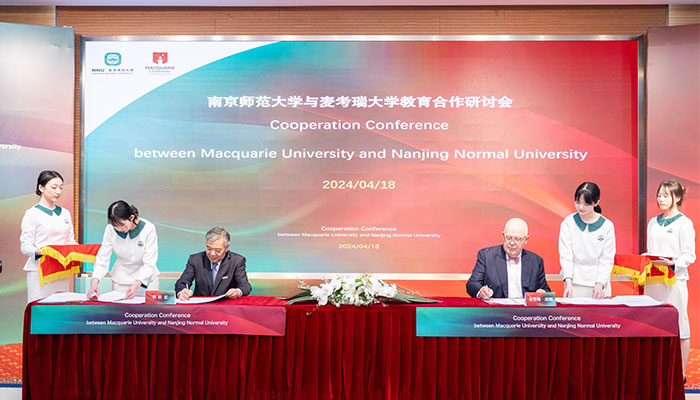A new theoretical quantum engineering system designed by Australian researchers opens up exciting opportunities for telecommunications and optical devices through the emerging area of all-optical light pulse routing, as reported overnight in the journal Physical Review X.
“The routing and switching of light pulses into different paths is a challenging but vital component in both classical telecommunications and quantum information processing,” says author Jason Twamley.
Most existing schemes for all-optical light pulse routing have drawbacks, however, in that they typically require very intense laser light to control the switching and thus use large amounts of energy. In addition, they typically only enable switching of light pulses but not routing.
“In our work we show theoretically how a quantum system can be used to switch and route light pulses with very high contrast and with very low power – opening up newer, higher bandwidths," says co-author Keyu Xia.
The ARC Centre of Excellence in Engineered Quantum Systems, in which Twamley and Xia work, aims to develop control over the quantum world.
“Within this goal, our work has led to a novel application of where the detailed manipulation of an individual quantum system may have very practical uses for telecommunications and integrated quantum optical devices,” says Xia.
In the design the duo use a three level atomic-like system which is coupled to two nearby optical cavities. By manipulating the internal quantum state of this atomic system via an external laser pulse they show that one can couple and decouple the two nearby optical cavities - thus enabling light within these cavities to be switched or routed.
“To build the system, we envisage using a chip-based technology where optical pulses are stored in “photonic crystal” cavities and the “atomic-like” system could be a Nitrogen-Vacancy defect in a nanodiamond,” says Twamley.
Additionally, the scheme can take weak input light pulses and output multiple light pulses which are quantum entangled if the individual “atomic-like” control systems are themselves quantum entangled.
All-Optical Switching and Router via the Direct Quantum Control of Coupling between Cavity Modes, Keyu Xia and Jason Twamley, ARC Centre of Excellence in Engineered Quantum Systems, Department of Physics and Astronomy, Macquarie University, NSW 2109, Physical Review X - online open access
------
Launched in August 2011, PRX is APS’s online-only, fully open-access journal with an author-pays model. In addition to its highly selective and thorough peer-review process, PRX's editorial policies are both broad-minded and responsive to the most current and emerging developments in physics. With these defining features, PRX aims to bring innovative and exceptional results to the broad science and engineering communities.
The American Physical Society is a non-profit membership organization working to advance and diffuse the knowledge of physics through its outstanding research journals, scientific meetings, and education, outreach, advocacy and international activities. APS represents 50,000 members, including physicists in academia, national laboratories and industry in the United States and throughout the world. Society offices are located in College Park, MD (Headquarters), Ridge, NY, and Washington, DC.
“The routing and switching of light pulses into different paths is a challenging but vital component in both classical telecommunications and quantum information processing,” says author Jason Twamley.
Most existing schemes for all-optical light pulse routing have drawbacks, however, in that they typically require very intense laser light to control the switching and thus use large amounts of energy. In addition, they typically only enable switching of light pulses but not routing.
“In our work we show theoretically how a quantum system can be used to switch and route light pulses with very high contrast and with very low power – opening up newer, higher bandwidths," says co-author Keyu Xia.
The ARC Centre of Excellence in Engineered Quantum Systems, in which Twamley and Xia work, aims to develop control over the quantum world.
“Within this goal, our work has led to a novel application of where the detailed manipulation of an individual quantum system may have very practical uses for telecommunications and integrated quantum optical devices,” says Xia.
In the design the duo use a three level atomic-like system which is coupled to two nearby optical cavities. By manipulating the internal quantum state of this atomic system via an external laser pulse they show that one can couple and decouple the two nearby optical cavities - thus enabling light within these cavities to be switched or routed.
“To build the system, we envisage using a chip-based technology where optical pulses are stored in “photonic crystal” cavities and the “atomic-like” system could be a Nitrogen-Vacancy defect in a nanodiamond,” says Twamley.
Additionally, the scheme can take weak input light pulses and output multiple light pulses which are quantum entangled if the individual “atomic-like” control systems are themselves quantum entangled.
All-Optical Switching and Router via the Direct Quantum Control of Coupling between Cavity Modes, Keyu Xia and Jason Twamley, ARC Centre of Excellence in Engineered Quantum Systems, Department of Physics and Astronomy, Macquarie University, NSW 2109, Physical Review X - online open access
------
Launched in August 2011, PRX is APS’s online-only, fully open-access journal with an author-pays model. In addition to its highly selective and thorough peer-review process, PRX's editorial policies are both broad-minded and responsive to the most current and emerging developments in physics. With these defining features, PRX aims to bring innovative and exceptional results to the broad science and engineering communities.
The American Physical Society is a non-profit membership organization working to advance and diffuse the knowledge of physics through its outstanding research journals, scientific meetings, and education, outreach, advocacy and international activities. APS represents 50,000 members, including physicists in academia, national laboratories and industry in the United States and throughout the world. Society offices are located in College Park, MD (Headquarters), Ridge, NY, and Washington, DC.



